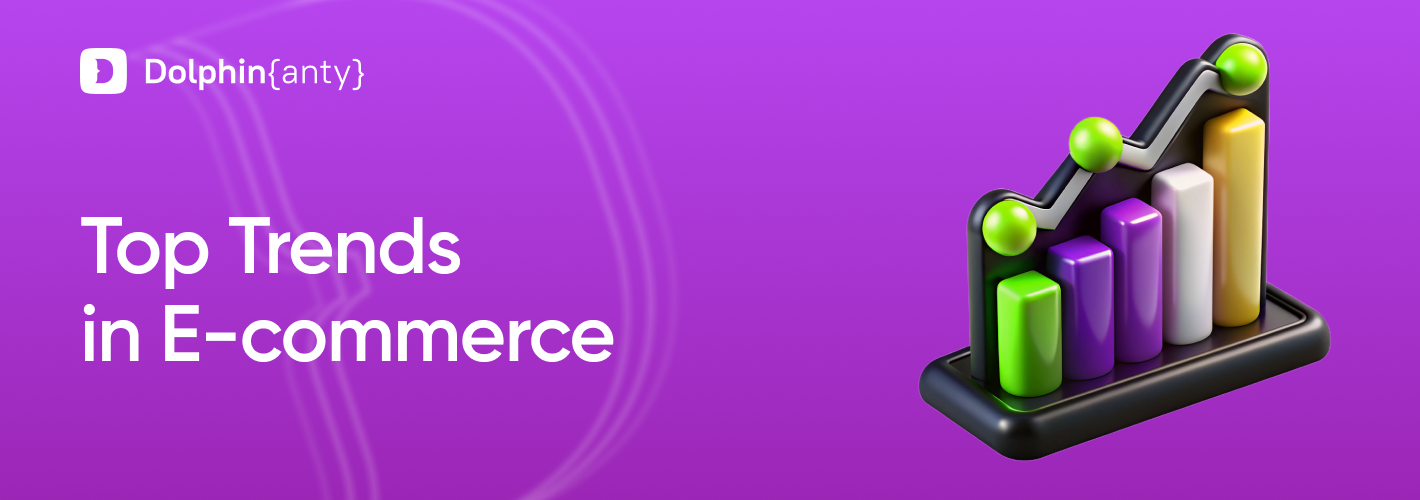E-commerce: Top Trends in 2025
Blog » E-commerce: Top Trends in 2025
Each year brings something new to 🤝 affiliate marketing. Even if you feel like you’ve finally learned everything and nothing can surprise you, there’s always a chance for a new trend to emerge. That’s why it’s better to think in advance because advertising and promotion don’t tolerate stops — you have to move forward and upward only.
Today, we’ll talk about the 🏪 e-commerce and what to expect from it in 2025. Let’s start with the fact that the transition of many aspects of life into online shows no signs of slowing down. Because of this, almost any product can be found and purchased on the internet.
That’s why we’ve prepared a list of the most 📈 notable e-commerce trends that are worth paying attention to. We’ve also gathered some useful tips and the best marketing tools to help you succeed.
Trend №1: Mobile Traffic
Shopping via 📱 mobile devices is gradually but steadily taking over e-commerce. So it’s no surprise that in recent years, the growth in product sales has mainly been driven by the rise in mobile traffic.
The share of mobile traffic in purchases in the world’s largest market — the U.S. — hasn’t shown explosive growth in percentage terms, increasing by just 7% since 2019. However, consumer spending over the same period has more than tripled. In 2025, Americans are expected to spend 💰 $710 billion in e-commerce. Nearly half of that — $312 billion, or 44% — will come from mobile purchases. These figures clearly show that both consumers and marketers have already recognized the high potential of mobile commerce.
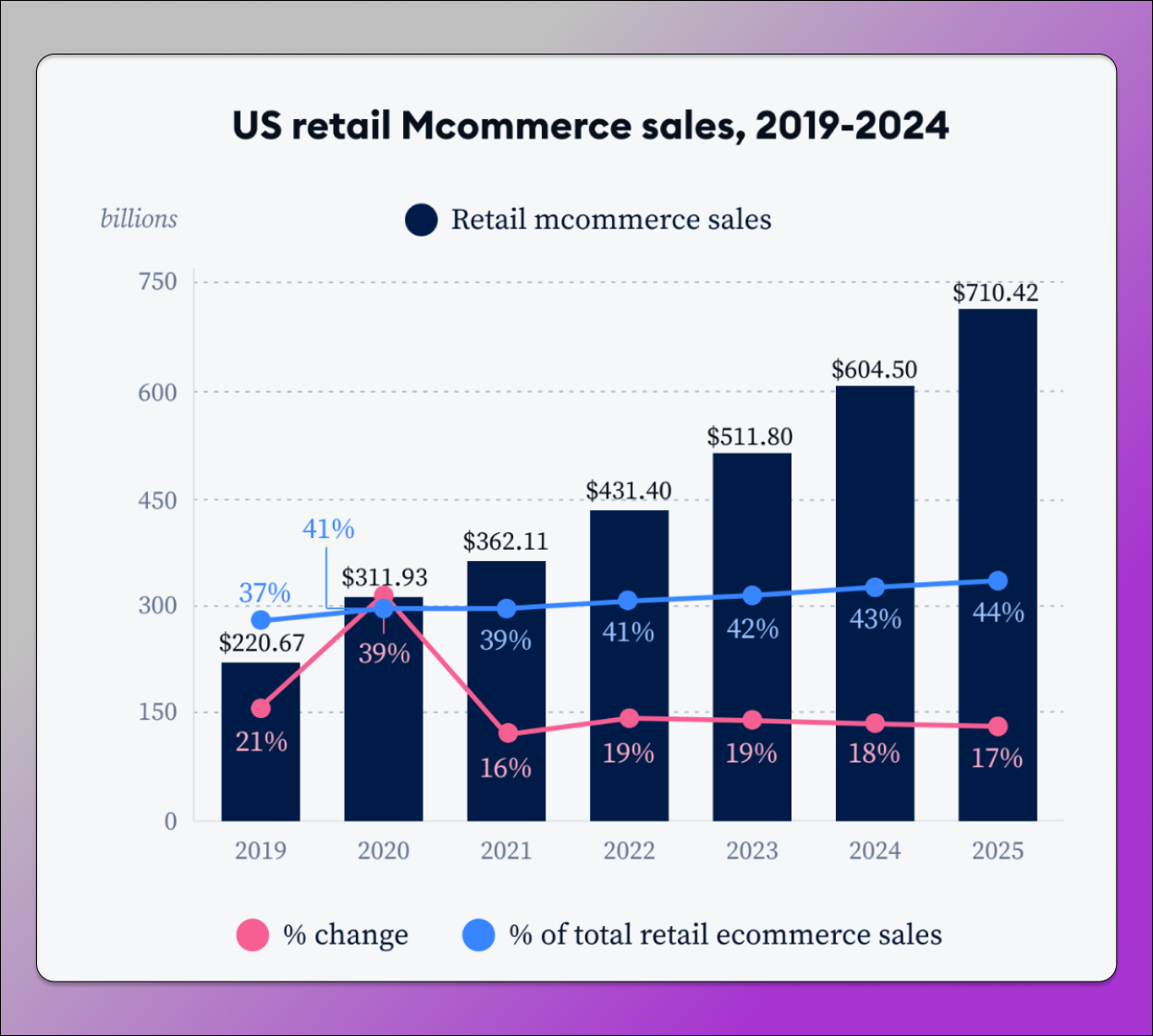
Data by Tidio.
The global market outlook is even better. According to Statista forecasts, mobile device spending will account for 62% of the 💰 $3.4 trillion total in 2027, reaching $2.1 trillion.
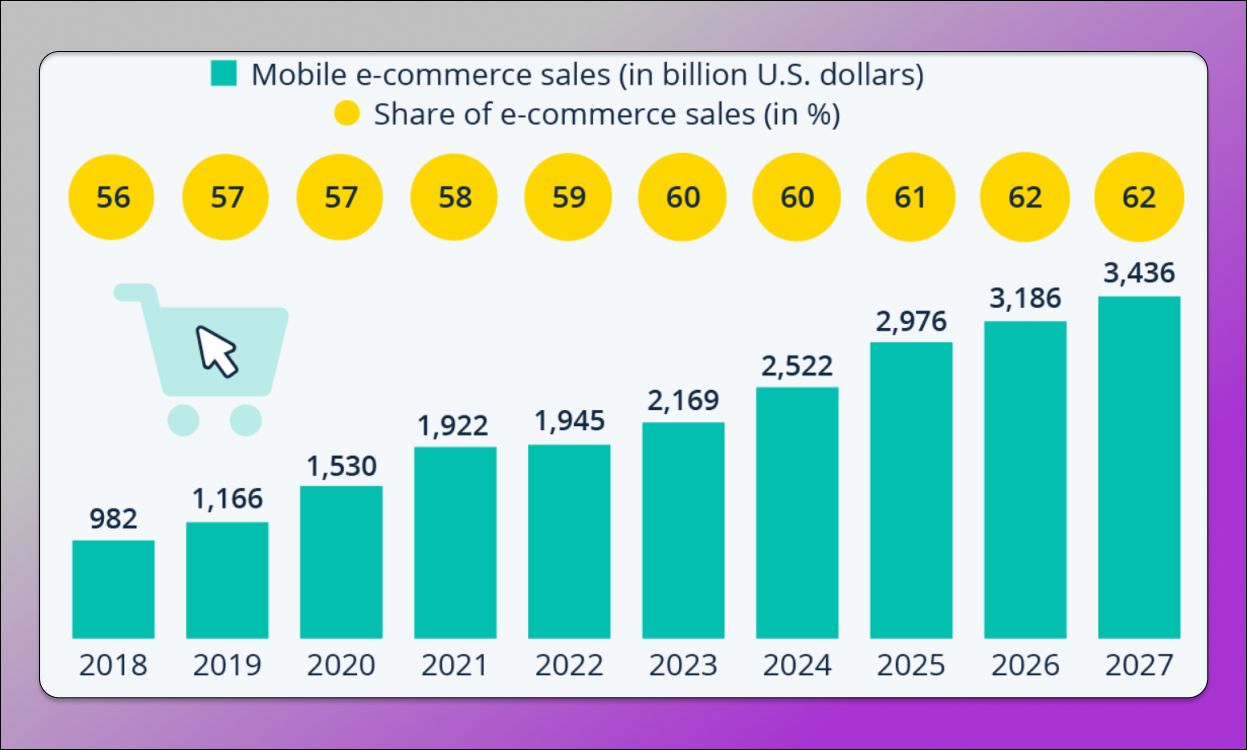
Data by Statista.
That’s why the first question every affiliate partner working with product offers should ask is: 🤔 is the store’s website or landing page optimized for mobile devices? Many users don’t appreciate tiny elements on a page that are hard to tap, as they are the main obstacle to mobile purchases.
Additionally, mobile landing pages should be as simple as possible. While creating them, pay special attention to the following aspects:
- Clear text. Remove any unnecessary words, as mobile shoppers make highly specific queries. Provide only the most relevant information based on their current stage in the sales funnel.
- Image optimization. Make sure that images have the right size and resolution to be displayed correctly on any mobile screen. There are many tools available to adjust uploaded images based on page width.
Trend №2. Shopping on Social Networks
Shopping on social networks is possible thanks to the integration of marketplaces into them. This trend has shown significant growth in recent years. Many platforms allow users to make purchases directly within the app without leaving it. This simplifies shopping and creates new opportunities for businesses.
And here are some statistics on FB, which now has over 3 billion users:
- Up to 40% of 3.07 billion monthly active users make purchases on Marketplace.
- Around 491 million people, or 16% of active users, visit the social network solely to shop on Marketplace.
- 250 million sellers worldwide use Marketplace.
- 51.2% of all social media users made their last purchase through Marketplace.
- Among recent buyers, 77.4% purchased via Marketplace, 14.4% via Shops, and 8.12% via Messenger.
- More than half of the users (54.2%) who regularly click on ads, go on to make a purchase.
- Marketplace is available in 228 countries and territories worldwide.
And it’s also the most popular shopping platform among millennials.
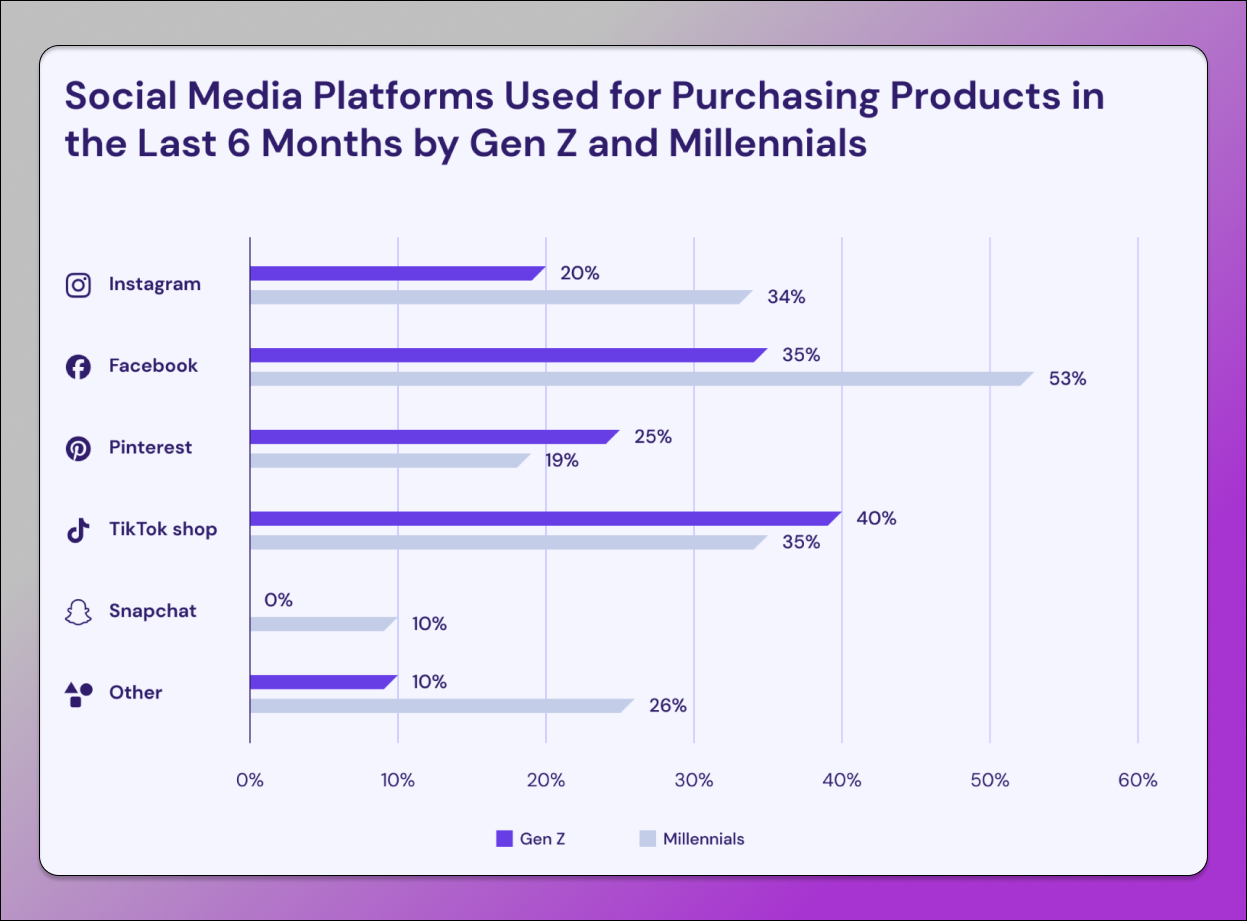
Millennials vs. Gen Z: Shopping Platform. Data by Hostinger.
Gen Z, on the other hand, prefers TT for shopping, as it also offers built-in e-commerce features. It allows users to make purchases without leaving the app and enables brands to showcase products as cards in videos, feeds, or even during live streams.
The main features of the built-in store include ⬇️
- Integration into content. Sellers can add links to their products in videos and live streams, allowing users to click on them and purchase directly without leaving the app.
- Live stream shopping. The platform is actively developing the “Live Shopping” feature, where sellers can showcase their products in real time, and users can purchase them instantly.
- Partnerships with platforms. TT shop is integrated with e-commerce platforms like Shopify, making the selling process easier for both small and large businesses.
Currently, Shop is available in several countries, including the U.S., the U.K., and some Asian regions, and it continues to expand. In the coming years, TT is expected to become a major player in the social commerce market, especially for brands targeting a younger audience.
Social commerce is perfect for customers who don’t want to spend time reading long product descriptions or browsing multiple store categories. It’s for those with a “see it, buy it” mentality. They want to spot the product they need, add it to their cart, and proceed to checkout immediately.
Trend №3: AI-powered Personalized Product Recommendations
Consumer psychology studies show that many shoppers would opt for a more expensive product than they originally planned if offered a more personalized shopping experience.
Artificial intelligence (AI) is used to predict customer behavior based on their browsing and purchase history. When it comes to personalized product recommendations, 🤖 AI-powered technology has no rivals. While no developer can create a separate website tailored to every individual visitor’s needs, AI can handle this task by offering a set of products that instantly meets all their demands.
Thus, we are witnessing not just ad personalization but ☝️ hyper-personalization powered by AI, where each subsequent interaction with the customer is based on their behavior.

Amazon leverages AI to its fullest potential — 35% of its revenue comes from upselling and cross-selling.
Sounds promising, but how does it work in affiliate marketing? There are many forms of product recommendations. By understanding their peculiarities, you can easily combine them to maximize your influence on customer purchasing decisions within an ad campaign. The main strategies include:
- Upselling is a technique where customers are offered similar but more expensive or premium products. This tactic is useful if you’re promoting items across different price segments and want to increase the average order value.
- Post-purchase upselling is a risk-free tactic that allows sellers to bring customers back immediately after completing a purchase. It displays new offers on the “Thank You for Your Order” page and usually includes enticing deals.
- Cross-selling is the practice of offering additional or compatible products to those already in the cart. For example, headphones can be a great cross-sell item for smartphones.
🛠 Precisely targeted ad campaigns based on what potential buyers have viewed will help affiliates earn more. Affiliate programs that are the first to offer partners effective AI-powered tools will also come out on top.
Trend №4: Visual Commerce
We are living in an era of informational noise, where companies use every possible tool to capture consumer attention. Remarketing, retargeting, trigger email campaigns, pop-ups, widgets, contextual advertising — the list goes on. However, most buyers want to have an opportunity just to add a product to their cart and complete their purchase quickly.
That’s why 👀 visual communication is more important than ever. Affiliates should leverage high-quality images, videos, and even augmented reality technologies to capture buyers’ attention and increase engagement.
Simply put, visual commerce is a strategy that uses images, videos, and other creatives to help buyers get acquainted with a product faster and make a purchase decision.
Here are some useful tips to capture buyers’ attention:
- Use the WebP format instead of JPG and PNG. This will improve image quality and speed up page loading.
- Make visual content searchable — use accurate descriptions and tags on creatives so visitors can find them when looking for a product.
- Leverage user-generated content by turning it into interactive galleries on landing pages. This will boost engagement, strengthen brand trust, and increase conversion rates.
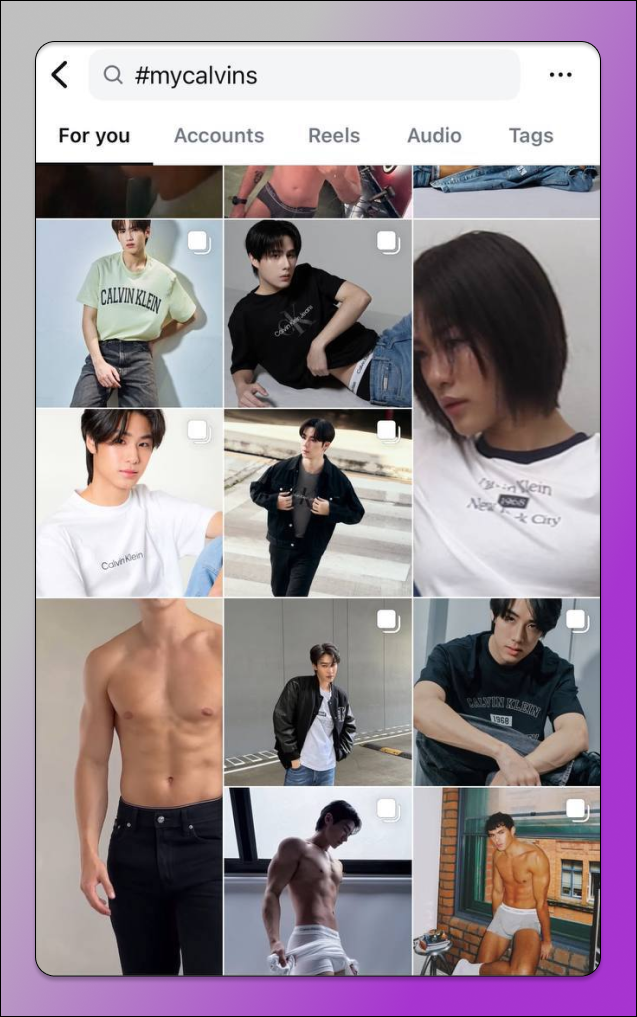
Searching IG by the hashtag #mycalvins already provides tons of creative ideas.
- Create shopping ads on Pinterest to drive traffic to your online store and boost sales.
Trend №5. Omnichannel Commerce
We live in a multichannel and omnichannel environment, and to succeed, you need to stay on trend. Or rather, on trends. But first, let’s break down the key concepts.
- Multichannel Approach — this strategy involves a company’s presence across various platforms: mobile apps, websites, social media, offline stores, and more. However, modern consumers seek a seamless brand experience rather than chaotically switching between separate channels.
- Omnichannel Approach — this is the next level of multichannel. It allows customers to start searching for a product in one channel and smoothly switch to another without losing context. The omnichannel strategy enhances the multichannel approach by optimizing it for the modern audience’s needs.

According to Omnisend data, using three or more channels instead of just one increases the purchase rate by 287%.
The omnichannel approach to product promotion offers 👍 several advantages:
- Seamless communication. Omnichannel marketing ensures cohesive and coherent messaging for customers. No matter where a user encounters an ad, the information will be clear, strengthening trust and enhancing the user experience.
- A complete view of the customer journey. The omnichannel strategy helps integrate and analyze data from different channels, creating detailed customer profiles. The more data you collect, the better you can tailor product recommendations and personalize the customer experience.
- Personalization and LTV Growth. Customers who use multiple channels have a 30% higher lifetime value (LTV) than those who engage with only one. Omnichannel marketing unlocks vast opportunities for personalized marketing and more precise targeting.
What Else Should You Pay Attention to? 🤔
The trends described here are not the only ones that will impact e-commerce this year. Depending on the business niche, geography, marketing budget, and other factors, you should consider the following aspects too:
- Focus on sustainable development and eco-friendly consumption. The “green” trend remains in demand as it effectively attracts customers and helps brands stand out from the competition.
- Fast payment methods. This is one of the most relevant trends in e-commerce. Fast fashion, fast purchases, fast payment options. The world is moving rapidly, and your advertising campaigns should keep up with this pace.
- Distribution by subscription. Subscription models have already proven their effectiveness for various online businesses. It is highly likely that more companies will seek ways to transition to SaaS. This model works great for customer retention, increasing loyalty and the likelihood of repeat purchases.
Conclusion
E-commerce is one of those verticals that will always exist because people physically cannot survive without it. For affiliates it means new opportunities and challenges now and then. Cutting-edge technologies, creative designs, and a variety of new marketing tools will help you build a strategy, find your niche, and reach the top.
